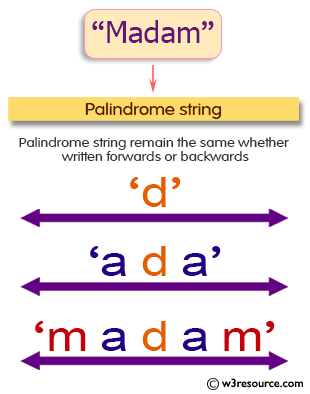Given a string s, return the longest
palindromic
substring in s.
Example 1:
Input: s = "babad"
Output: "bab"
Explanation: "aba" is also a valid answer.Example 2:
Input: s = "cbbd"
Output: "bb"Constraints:
1 <= s.length <= 1000sconsist of only digits and English letters.
This is my solution 1.
C++
#include <algorithm>
using namespace std;
class Solution {
public:
bool isPalindrome(string &s, int index, int len) {
//s[i]==s[s.size()-1-i]
//s[0]==s[s.size()-1]
int begin = index, end = index + len - 1;
while (begin < end) {
if (s[begin] != s[end]) {
return false;
} else {
begin++;
end--;
}
}
return true;
}
string longestPalindrome(string s) {
// for each s[i,j], we judge if it is palindrome.
// if it is palindrome, then compare it with previous max length.
int maxm = 1;
string res;
int start = 0;
for (int i = 0; i < s.size(); i++) {
// if has got a palindrome, then the next must bigger than current
// j means length of substring
for (int j = max(2, maxm); i + j - 1 < s.size(); j++) {
if (isPalindrome(s, i, j)) {
if (maxm < j) {
start = i;
maxm = j;
}
}
}
}
return s.substr(start, maxm);
}
};Although using dynamic programming costs more time in leetcode, i still consider it is a good idea. This solution is referring to a solution in leetcode. After understanding that solution, i try to write code from my memory to check if i really undertstand. But i found it is too hard to understand his loop variable. Thus i just follow my heart and use recursive to solve that problem.
C++
using namespace std;
class Solution {
public:
int isPalindrome(int dp[][1000], int i, int j, string &s) {
if (i == j) {
dp[i][j] = 1;
} else if (i + 1 == j) {
// 'bb'
dp[i][j] = s[i] == s[j];
} else {
if (dp[i + 1][j - 1] == -1) {
dp[i][j] = s[i] == s[j] && isPalindrome(dp, i + 1, j - 1, s);
} else {
dp[i][j] = s[i] == s[j] && dp[i + 1][j - 1] == 1;
}
}
return dp[i][j];
}
string longestPalindrome(string s) {
// init an array, dp[i][j].
int n = s.size();
int dp[1000][1000];
for (int i = 0; i < n; i++) {
for (int j = 0; j < n; j++) {
dp[i][j] = -1;
}
}
// i means begin of the substring while j means end of the substring
// dp[0][0]=true means s.substr(0,1) is palindrome
// dp[0][3]=true means s.substr(0,4) is palindrome
// dp[0][3]=s[0]==s[3] && dp[1][2]
// dp[1][2]=s[1]==s[2]
// thus dp[i][j]=s[i]==s[j] && dp[i+1][j-1], i+1 <= j-1
// we check all the possibilities of substring
int max_len = 0;
int max_begin = 0, max_end = 0;
for (int i = 0; i < n; i++) {
for (int j = i; j < n; j++) {
// check if substring(i,j) is palindrome
if (isPalindrome(dp, i, j, s)) {
int curr_len = j - i + 1;
if (curr_len > max_len) {
max_len = curr_len;
max_begin = i;
max_end = j;
}
}
}
}
// record begin and end of the max substring
return s.substr(max_begin, max_end - max_begin + 1);
}
};I guess it is the best solution. It is really efficient.

C++
class Solution {
public:
string ans = "";
void expand(string &s , int left ,int right)
{
while(left >= 0 && right < s.size())
{
if(s[left] != s[right])
break;
left--,right++;
}
if(ans.size() < right - left )
ans = s.substr(left + 1 , right - left - 1);
}
string longestPalindrome(string s) {
for(int i = 0 ; i < s.size() ; i++)
{
expand(s , i , i);
expand(s , i , i+1);
}
return ans;
}
};